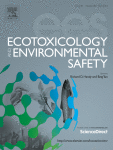Ver ítem
- xmlui.general.dspace_homeCentros e Institutos de InvestigaciónCICVyA. Centro de Investigación en Ciencias Veterinarias y AgronómicasInstituto de Microbiología y Zoología AgrícolaArtículos científicosxmlui.ArtifactBrowser.ItemViewer.trail
- Inicio
- Centros e Institutos de Investigación
- CICVyA. Centro de Investigación en Ciencias Veterinarias y Agronómicas
- Instituto de Microbiología y Zoología Agrícola
- Artículos científicos
- Ver ítem
Effects of 17α-ethinylestradiol on sex ratio, gonadal histology and perianal hyperpigmentation of Cnesterodon decemmaculatus (Pisces, Poeciliidae) during a full-lifecycle exposure
Resumen
The effects of 17α-ethinylestradiol (EE2) on sex ratio, gonopodium morphology, and gonadal histology of C. decemmaculatus were assessed by a full-lifecycle exposure experiment. Newborn fish were waterborne exposed to 30, 100, and 300 ng EE2/L for 90 d, using 50 fish per treatment. Additionally, in December of 2016, a field survey was conducted on a C. decemmaculatus population inhabiting the Girado Creek downstream of the Chascomus city wastewater
[ver mas...]
The effects of 17α-ethinylestradiol (EE2) on sex ratio, gonopodium morphology, and gonadal histology of C. decemmaculatus were assessed by a full-lifecycle exposure experiment. Newborn fish were waterborne exposed to 30, 100, and 300 ng EE2/L for 90 d, using 50 fish per treatment. Additionally, in December of 2016, a field survey was conducted on a C. decemmaculatus population inhabiting the Girado Creek downstream of the Chascomus city wastewater effluent discharge. After 90 d of exposure, EE2 was able to histologically skew the sex ratio toward females and inhibit the full gonopodium development since the lowest tested concentration (LOEC = 30 ng/L). At higher concentrations, EE2 was toxic, inducing mortality in a concentration-dependent fashion (90 d-LC50 = 109.9 ng/L) and altering the gonadal histoarchitecture, causing neither testes nor ovaries discernible histologically (LOEC = 100 ng/L). In addition, a novel response, perianal hyperpigmentation, was discovered been induced by the EE2 exposure in a concentration-dependent fashion (90 d-EC50 = 39.3 ng/L). A higher proportion of females and perianal hyperpigmentation were observed in wild fish collected from the Girado Creek. The major reached conclusions are: i) EE2 induce different effects on the sexual traits of C. decemmaculatus when exposed from early-life or adult stages. ii) The most sensitive effects observed in the laboratory occur in a creek receiving wastewater effluent. iii) The perianal hyperpigmentation comes-up as a promising biomarker of exposure to estrogenic compounds.
[Cerrar]

Autor
Young, Brian Jonathan;
Cristos, Diego Sebastian;
Crespo, Diana Cristina;
Somoza, Gustavo Manuel;
Carriquiriborde, Pedro;
Fuente
Ecotoxicology and Environmental Safety 205 : art. 111176. (2020).
Fecha
2020-08-11
Editorial
Elsevier
ISSN
0147-6513
Formato
pdf
Tipo de documento
artículo
Palabras Claves
Derechos de acceso
Abierto
 Excepto donde se diga explicitamente, este item se publica bajo la siguiente descripción: Creative Commons Attribution-NonCommercial-ShareAlike 2.5 Unported (CC BY-NC-SA 2.5)
Excepto donde se diga explicitamente, este item se publica bajo la siguiente descripción: Creative Commons Attribution-NonCommercial-ShareAlike 2.5 Unported (CC BY-NC-SA 2.5)


